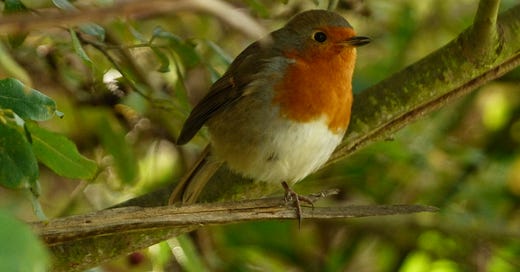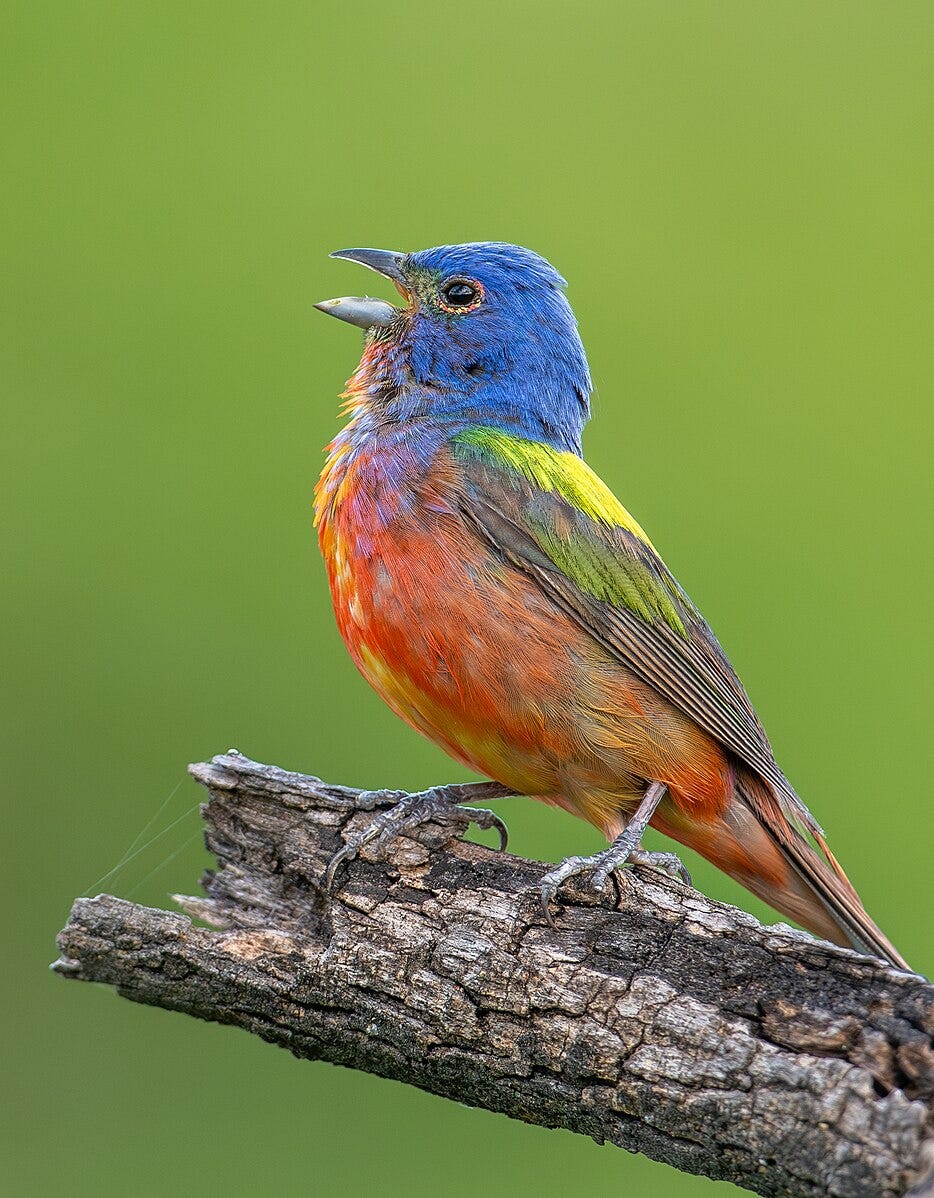Hello. Welcome. Thanks for being here.
Every week in 2025, as well as the regular Six Things posts, I’ll be writing about birds. If birds aren’t your thing, perhaps I can lure you into their evil world. And if no absolutely not, then you can always toggle your preferences so you only get what you want.
For those who stay, there will be:
– a bit about my birding activities that week
– micro-essays about two British birds
– a couple of news-y or science-y or otherwise of interest bits from elsewhere
I hope you enjoy it all.
On The List
I saw some birds this week. I'm pretty sure they saw me too. They're good like that, birds.
New Year means new list, and while I'm not obsessive about it, I like to keep track. I don’t list to hit a target. Not any more. Target-chasing was at least in part the basis for my book Why Do Birds Suddenly Disappear? – could I, on the back of the resurgence of my childhood interest in birds, clock up a total of 200 British species in a year? The book wasn’t all about the target, but it proved useful – ever competitive, I nudged myself towards it, and in so doing established an unbreakable habit. Noticing birds has become a low-level background activity, as natural and regular a part of my life as tripping over the cat on the way downstairs. So the keeping of bird lists, for some people a ridiculous idea, has, in its own quiet way, changed my life. And by regularly uploading my records to the British Trust for Ornithology’s BirdTrack, I like to think I’m doing my bit for citizen science.
But the list itself tells only part of the story.
The entry ‘raven: 2’ confirms that these magnificent corvids were the first birds I saw this year (that in itself is remarkable enough, I suppose), but it doesn’t show them gronking and tumbling over a field on the edge of Dartmoor, embodying the freedom of flight and the unscientific notion that birds sometimes fly just for fun.
Similarly, the simple word ‘buzzard’ doesn’t do justice to the rough cragginess of the bird I saw perched on a telegraph pole next to the M5 – like any motorway raptor sighting, the risk of glancing away from the road for an instant was outweighed by the pleasure derived from it. (And if you’re worried, no I didn’t upload the sighting while driving – my recklessness has its limits.)
As for ‘house sparrows: +/-10’, the number is part guesswork, part experience – they hide in the hedge and chat (and chat and chat and chat), the definition of chirpy, their garrulousness the source of guaranteed uplift on a dreary January morning. By listening carefully, you can just about guess how many there are hidden in the leafy depths.
And so it goes. You see a bird, you note it, and that very act is often enough to embed the memory for future reference – a catalogue of little pleasure hits to draw on in times of darkness.
All hail, then, and in all its forms, The List – world lists, country lists, county lists, garden lists, glimpsed-while-driving lists, seen-through-the-kitchen-window-while-doing-the-washing-up lists, whichever takes your fancy. They make the birding world go round.
The Robin
You have to start with the robin. National bird, you know. The gardener's friend, probably the most familiar British bird – the one even the most nature-averse might recognise. Confident, trusting, friendly. John Clare described it as the “tamest of the feathered race”. And he knew a thing or two.
There it is, on your Christmas cards, looking out from the inevitable snowy scene: pert, big-eyed, adorable. They nest in strange places – under car bonnets, in toilet cisterns, up drainpipes. A robin in Birmingham waited for a human to have breakfast before making its nest in the unoccupied, unmade bed. Aww, bless. Sweet little floof.
Except, not so much.
That silvery ribbon of song – tswee-ooOoOo-s’b’widdle-ibalooOOoo – might be a euphonious sound apparently designed to lift the human heart. But then you read that robins are aggressively territorial, sometimes fighting to the death, and you reimagine the song as something like “listen, pal, come an inch closer and you can get ready for a broken fucken wing”, which is the kind of knowledge that can make you go right off a bird. The gardener's friend? Alex Preston, in As Kingfishers Catch Fire, was nearer the mark: “that jaunty, bloodthirsty bird”.
We should give its full name – European Robin – partly to please the purists, partly to differentiate it from the American version (not to mention the nearly 100 birds round the world whose names contain the word “Robin”). Early European settlers, no doubt thoroughly discombobulated by all sorts of things, sought comfort in the familiar, and allotted names accordingly.
“Look at that smallish bird with a reddish breast, eating worms.”
“A robin!”
“Weeellll.... I mean, apart from the size and all the other markings and also it looks more like a thrush.”
“Shush.”
"A robin!"
That song, then. A piping, trembling warble with judiciously placed gaps.
Sing. Wait. Sing. Wait.
The musician in me appreciates the bird's understanding of the importance of silence; the naturalist knows that the gaps allow competing robins to assert their claim, thus enabling the clear demarcation of rival territories.
Unusually, they sing almost year-round. And contrary to traditional wisdom, it's now known that female robins sing just as devotedly as males, especially in autumn and winter. People who know – and who have certainly spent longer studying these things than I have – will often tell you that this autumnal song is sadder, more melancholy than the perky song of spring. I feel either treacherous or ignorant when I say this: I can't tell the difference.
Perhaps it's association. Autumn – a time of decay, shortening daylight hours, retreat into darkness – often induces melancholic thoughts in humans. How natural, how understandable, to project these thoughts onto the most audible manifestation of the turning of the year. The robin is doing no more nor less than proclaiming its right to a territory. How we choose to interpret those sounds says more about us than it does about them.
ID: the only British bird with the brown/orange combination; plump; likes to hop along the ground.
Where: gardens, parks, woods, hedges, open country – throughout Britain.
Sounds: silvery, liquid flutings and ripplings; nervous tick-ti-tik-tik.
Further reading:
David Lack – The Life of the Robin
Stephen Moss – The Robin: A Biography
The Greylag Goose
You know how words sometimes go funny on you? Perfectly normal words, like, say, goose.
Goose goose goose goose.
After a few repetitions, there seems nothing odder in the world than the word “goose”.
Semantic satiation, it’s called. And the thing to do is to work through it until the word returns to normal and takes its place alongside all the others.
Well, that’s what’s just happened to me, except it’s not the word ‘goose’ (although now you come to mention it is a bit odd) so much as the bird goose.
I found myself looking at photographs and drawings of geese in general, and Greylags in particular, and now, just for the moment, I can think of nothing more deranged and out of this world and just downright weird than a Greylag Goose. A cheese dream of a bird, with its… GOOSENESS.
Ok, I’m over it.
You know the Greylag. They’re similar in appearance to several other varieties – Pink-Footed, Bean, White-Fronted – but the Greylag is the one you’re most likely to have a close encounter with. Walk through a London park and there it'll be, striding towards you with menace in its step and a demanding honk, a honk that says “GIVE ME FOOD OR SUFFER THE CONSEQUENCES”. No wonder they were, according to legend, the animals chosen to defend Rome in 390 BC.
We have a longstanding relationship with these stocky, belligerent honkers. We domesticated them about 5,000 years ago, and, as was and is often the way, treated them both with disdain (killing them, eating them, plucking their feathers for pillows and pens and such like) and reverence (they were sacred to Aphrodite for Greeks and Romans, carrying erotic connotations that seem frankly absurd to anyone who’s ever seen their comic waddle).
I’ll always give a Greylag a cheery wave if I meet it in the park, whether it’s floating harmlessly on the water or demanding food with menaces. But geese, for all that they’re officially water birds, belong in the air. Is there a more uplifting sight and sound than a straggly V of geese making their way across the skies, calling to each other with barking honks? Whether pinkfeet or greylag, white-fronts or Canada, or any of the several other species that grace our shores, the answer is no, there is not.
ID: large, heavy, lumbering
Where: urban ponds, parks. Freshwater lakes, farms, meadows. Roosts on marshes, estuaries etc
Sounds: haarrrkk haarrwk hwaaarrkkk
Further reading:
Nick Acheson – The Meaning of Geese
Fireworks
Many people love fireworks; most birds don’t.
Using weather radar, Dutch researchers monitored the number of birds taking to the air on ‘normal’ nights vs New Year’s Eve. The results are startling. Here is the radar around midnight on New Year’s Eve.
You can read more in this measured thread on Bluesky by Bart Hoekstra.
The source papers are here and here.
Jimmy
Jimmy Carter, who died on December 29th at the age of 100, was an avid birder – I did know this, but had forgotten, and reading about it again made me warm to him even more. Of course it did.
Here he is talking about birds in general:
And here he is talking about the time he saw a Painted Bunting.
About 69 seconds in, he smiles as he describes counting the colours on the bird. I recognise that smile. It’s the smile of vivid, remembered pleasure, and I love it.






My friend has a goose tattooed on his back, for magical reasons
Scrub jays have an amazing trick that I never saw any other bird do. One morning after we'd had about four inches of snow, I was watching out the window when a small flock of scrub jays arrived, attracted by a few clumps of tall grass whose seedy tops were sticking out of the snow. Four of them attacked a particular clump, hovering in a tight circle and beating the clump with their wings. This bared the immediate area of snow and apparently loosened the seeds. They alit and ate, then flew to another clump. Other subgroups in the flock were doing the same.
It was a feeding activity that benefited the whole group, not just a single foraging bird.